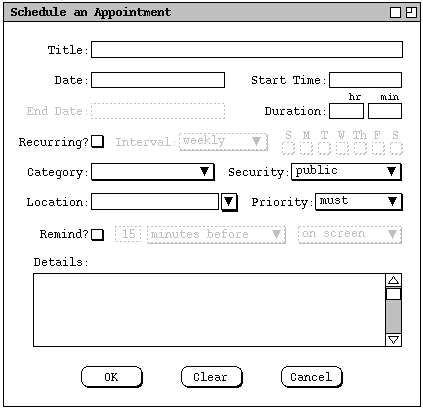
This introductory scenario shows an individual user scheduling two simple appointments. Appointment scheduling is one of the most commonly performed operations with the Calendar Tool. In this scenario, the user is assumed to have just been registered in the Calendar Tool. Hence the user has a brand new calendar with no entries and the standard default settings for all options. Details of user registration and default calendar creation are covered in Section 2.6.
To schedule an appointment, the user selects the `Appointment' command
in the
Schedule menu.
In response, the system displays the dialog shown in Figure 5.

Figure 5: Appointment scheduling dialog.
The information in the fourth row of the appointment dialog is used to specify whether, and if so how often an appointment recurs. Immediately to the right of the `Recurring?' label is a check box. If it is checked on, then information pertinent to a recurring appointment changes from disabled (greyed- out) to enabled (solid type). The recurring information is the `End Date', the recurring `Interval', and the seven daily check boxes to the right of the `Interval' box. The `Interval' selection is one of `weekly', `biweekly', `monthly', or `yearly'. Complete details on scheduling recurring items are covered in Section 2.5.3.
The appointment `Location' specifies where it will be held. The location value can be typed manually by the user or selected from a list of available locations, which are stored in the locations database. Further details of location definition and selection are covered in Sections 2.6.4 and respectively.
The appointment `Priority' indicates whether an appointment is a `must' or `optional'. The priority is used to indicate the general importance of an appointment to the user. The priority is also used in meeting scheduling, where optional appointments can be automatically scheduled over if necessary. Meeting scheduling is discussed further in Section 2.4.1.
The data-entry row starting with `Remind?' is used to enable the sending of a reminder prior to the start of the appointment. When the `Remind?' check box is on, the other reminder information changes from disabled to enabled. The two data-entry fields immediately to the right of the check box indicate how soon before the appointment the reminder is sent. The small box is a numeric value and the other box is one of the three alternatives `minutes before', `hours before', or `days before'. To the right of the time-before entry is a menu for selecting how the reminder should be sent. The choices are `on screen' or `email'. Details of these reminder formats are covered in Section 2.5.4.
The bottommost data-entry area in the appointment dialog is for writing a detailed description of the appointment. The user may enter any amount of free-form textual information in the `Details' field.
After the dialog appears on the screen, the user enters information by a
combination of typing and selecting from pre-defined choices. Figure 6 shows
the result of the user having filled in information for a new appointment
titled "Dentist".
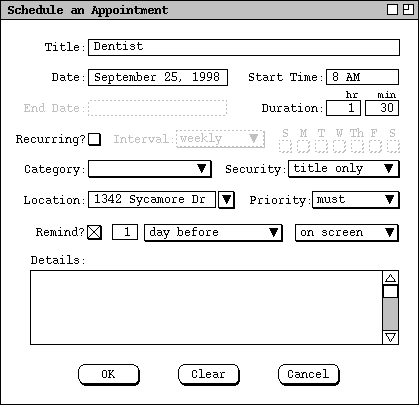
Figure 6: Scheduling a dentist appointment.
To create a new appointment category, the user initially selects the down arrow
next to the `Category' display box. In response, the system displays
the menu shown in Figure 7.

Figure 7: Initial categories menu.
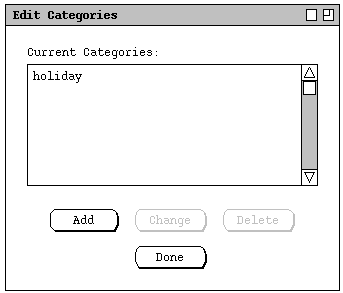
Figure 8: Edit categories dialog.
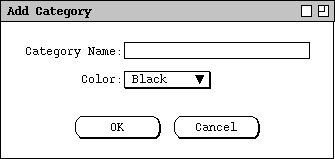
Figure 9: Add category dialog.
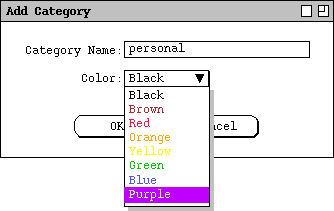
Figure 10: Creating a new category.
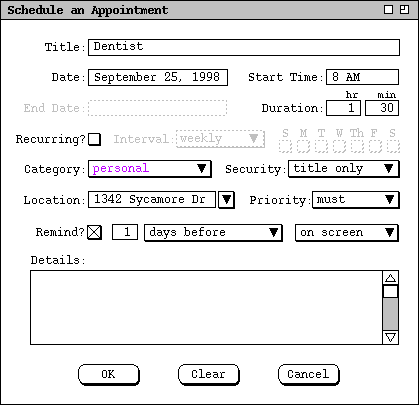
Figure 11: Dentist appointment with category filled in.
To confirm the scheduling of the dentist appointment, the user presses the `OK' button in the main schedule-appointment dialog. At this point, the dentist appointment is added to the user's personal calendar.
The user now proceeds to create another appointment, following the same
procedure as above for the dentist appointment. The resulting filled-in
appointment dialog is shown in Figure 12.
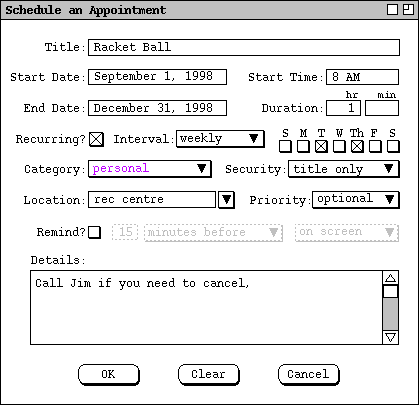
Figure 12: Scheduling a second appointment.
The user has set the priority for the new appointment to `optional' instead of `must'. The operative effect of selecting `optional' priority relates to scheduling meetings, which is discussed further in Section 2.4.1. Aside from meeting scheduling, the meaning of `must' versus `optional' is purely informational, i.e., it indicates the relative importance of the appointment.
When the user confirms a recurring appointment with the `OK' button, the system enters the appointment in calendar on all of the specified dates. That is, there is a separate instance of the appointment in the calendar for every date that meets the `Recurring' settings. For example in the case of the racket ball appointment in Figure 12, there are 36 appointment instances scheduled, since there are 36 Tuesday or Thursday dates between September 1 and December 31.
The information entered for a recurring appointment initially applies to all instances of the appointment. Subsequently, the user can change some or all of the information on a recurring appointment for some or all of the recurring dates. Details of how a recurring appointment is changed are covered in Section 2.5.2.1
To clear all information entered in an appointment dialog, the user presses the `Clear' button. In response, the system sets all data-entry fields to their default states. Details of default settings are covered in Section 2.7.3.1 To cancel a scheduling command entirely, the user presses the `Cancel' button. In response, the system clears the dialog and removes it from the screen, without performing any scheduling action. Details of the precise effects of `Clear' and `Cancel' are covered in Section .
After scheduling and confirming an appointment, the appointment data are entered in an online working copy of the user's calendar. In order for the appointments to be permanently saved in a calendar file, the user must invoke the `File Save' command, as discussed in Section . The user may save calendars in as many different files as desired. However, only specifically designated calendar files are visible to other Calendar Tool users and hence available for scheduling group meetings. Details of meeting scheduling and access to other users' calendars are covered in upcoming sections of the requirements.
After the user presses the `OK' button in the scheduling dialog, the
dialog itself is removed from the screen. The complete information for a
scheduled appointment can be viewed by selecting the `Item' command in
the `View' menu, or by double clicking on the title of an appointment
in a daily, weekly, or monthly calendar display. Details of these displays are
covered in the
next section
of the requirements.